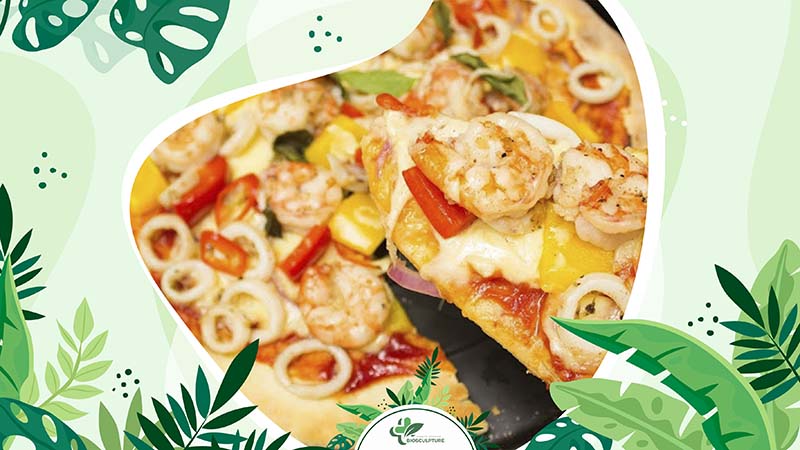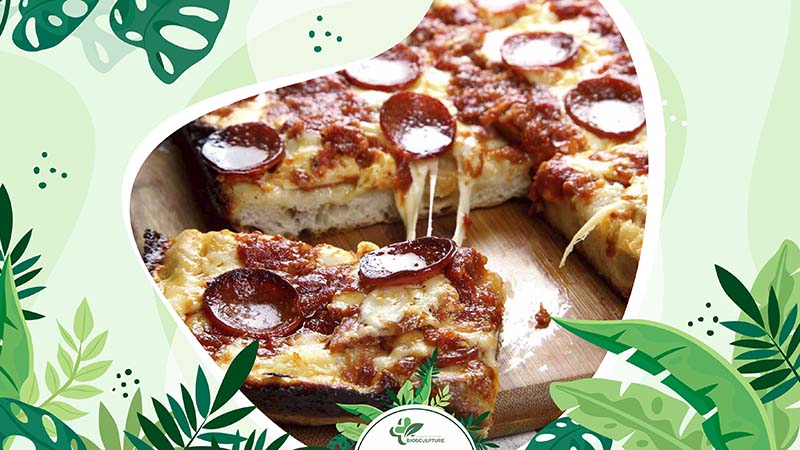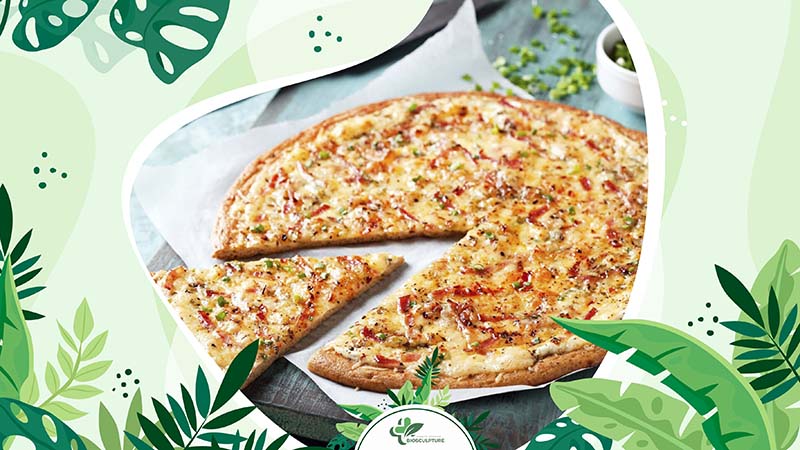Pizza, an enduring American favorite, prompts an essential question for those conscious of their dietary intake: “How many calories are in a slice of pizza?” This query becomes especially relevant for individuals striving to maintain a balanced diet while still enjoying this beloved dish. Given the vast array of pizza varieties, pinpointing the exact calorie count can seem daunting.
This blog post attempts to shed light on the calorie composition of different types of pizza, providing a clearer view of the calories in a slice of pizza. Additionally, we aim to offer guidance on making healthier pizza selections without forsaking flavor or satisfaction. Let’s explore interesting information about pizza with Biosculpture.

1. Caloric Content of a Slice of Pizza
Pizza is a beloved American dish, but it’s essential to be aware of its nutritional content, especially considering its potential impact on weight management. Despite being delicious, pizzas can be high in sugar and carbs, which may contribute to weight gain if consumed excessively.
On average, a single slice of pizza contains approximately 250-350 calories. However, specific types may vary in calorie content.
For instance, according to nutrition data, a slice of pepperoni, cheese, or meat lovers’ thin crust pizza with extra cheese typically ranges from 250 to 400 calories. Pepperoni and cheese slices usually clock in around 260 to 280 calories, while meat lovers’ slices can contain up to 577 calories. Additionally, these pizzas are often high in saturated fat, which can have adverse effects on your health.

2. Calorie Count in Various Popular Pizza Types
The calorie content of popular pizza types varies depending on factors like toppings, crust style, and serving size. Here’s a breakdown of the calorie count per slice for various types of pizza:
- Neapolitan Pizza: Neapolitan pizza, a classic Italian style, typically consists of tomatoes and mozzarella cheese. An 8-inch Neapolitan cheese pizza slice contains around 230 calories.
- Cheese Pizza: A medium hand-tossed cheese pizza slice contains about 200 calories, along with 25 grams of carbs, 8 grams of fat, 3.5 grams of saturated fat, 9 grams of protein, and 20 milligrams of cholesterol. Meanwhile, a quarter of a pie with a thin crust has approximately 290 calories, with 25 grams of carbs, 15 grams of fat, 7 grams of saturated fat, 12 grams of protein, and 35 milligrams of cholesterol.
- New York Style Pizza: Known for its thin, foldable crust, a slice of 8-inch New York-style cheese pizza has around 250 calories.
- Pepperoni Pizza: A slice of 8-inch pepperoni pizza contains roughly 275 calories, making it a flavorful option without significantly increasing the calorie count.
- Chicago Style Pizza: Chicago-style deep dish pizzas feature thick crusts and abundant toppings. A slice from an 8-inch deep dish cheese pizza typically contains about 280 calories.
- Detroit Style Pizza: Similar to Chicago-style, Detroit-style pizzas have a rectangular shape with crispy edges and crusts infused with butter or olive oil flavors. An 8-inch Detroit-style cheese pizza slice contains approximately 290 calories.

3. Does Eating Pizza Contribute to Weight Gain?
Yes, eating pizza can indeed contribute to weight gain. Pizza tends to be high in calories, saturated fat, and sodium, which can have adverse effects on cardiovascular health and lead to weight gain over time. Consuming just two or three slices of pizza, totaling around 800 to 1200 calories, can significantly increase your daily caloric intake and potentially result in weight gain if not balanced with healthier food choices.
Furthermore, the toppings commonly found on pizza, such as high-fat processed meats like pepperoni, bacon, and sausage, may heighten the risk of certain types of cancer if consumed regularly.
How you approach eating pizza matters as well. Regularly overindulging in pizza, especially multiple slices with high saturated fat content, can exceed the recommended limit for saturated fat intake, increasing the risk of heart disease and weight gain. Therefore, attention must be paid to portion sizes, toppings, and how often you enjoy pizza to maintain a healthy weight and overall health.

4. How to Eat Pizza in a Way That Minimizes Impact on Weight and Health
To minimize the weight and health impact of enjoying pizza, pay attention to portion sizes, toppings, and how often you enjoy it. Here are some tips to help you enjoy pizza in a healthier way:
- Choose whole-grain crust: Opt for pizzas with whole-grain crusts, as they are rich in fiber and essential nutrients. This can promote a feeling of fullness and contribute to a more balanced diet.
- Limit high-fat toppings: Steer clear of or reduce the amount of high-fat processed meats like pepperoni, bacon, and sausage. These toppings can increase the risk of certain cancers and add to weight gain. Instead, opt for vegetable toppings such as bell peppers, onions, mushrooms, and spinach for added nutrients and fiber.
- Practice portion control: Be mindful of the number of slices you consume in one sitting. A single slice of plain cheese pizza can contain around 400 calories, so keep track of your overall calorie intake for the day.
- Pair with balanced sides: Enjoy your pizza alongside a salad or other vegetables to ensure a well-rounded meal. This not only provides a variety of nutrients but also helps you feel satisfied, reducing the likelihood of overeating.
- Consider homemade pizza: Making pizza at home allows you to control the ingredients and portion sizes. Use whole-grain dough, low-fat cheese, and an abundance of vegetable toppings for a healthier alternative to store-bought options.
- Limit frequency: Reserve pizza as an occasional treat rather than making it a regular part of your diet. Avoid consuming pizza every day or even every week to maintain a balanced and varied diet.
5. When Is the Best Time to Eat Pizza?
The optimal timing for consuming pizza, particularly when considering its caloric impact, varies from person to person. Some enthusiasts argue that pizza is best enjoyed fresh out of the oven, while others swear by the enhanced flavors after refrigeration and reheating. When choosing store-bought pizza, check the expiration date to ensure freshness. Upon reheating, it’s imperative to heat the cheese to a temperature exceeding 165 degrees Fahrenheit. This practice is essential for eliminating any potential bacterial growth that could pose health risks.

It’s advisable to avoid reheating pizza multiple times. Each reheating cycle can not only degrade the quality and taste of the pizza but also increase the risk of foodborne illnesses due to temperature fluctuations that can promote bacterial growth.
6. Who Should Limit Pizza Consumption?
Individuals who should consider limiting pizza consumption include those who are watching their calorie intake, aiming to lose weight, or have specific dietary restrictions. Pizza can be high in calories, saturated fat, and sodium, which may contribute to weight gain and negatively affect cardiovascular health if consumed excessively.
However, pizza can still have a place in a balanced diet when enjoyed in moderation. Opting for pizzas made with whole-grain crust, lean protein, and abundant vegetable toppings can enhance its nutritional value. Additionally, incorporating side salads or other vegetables can help round out the meal and provide essential nutrients.
Furthermore, individuals with sensitivities or intolerances to certain ingredients, such as gluten or dairy, should be cautious with their pizza choices. Fortunately, there are options available, such as gluten-free crusts or dairy-free cheese, to accommodate these dietary needs.
7. Conclusion
The calorie content in each slice of cheese pizza can vary significantly, ranging from 230 to 290 calories based on the pie’s size and style. This highlights the importance of understanding “How many calories are in a slice of pizza?” when making dietary choices.
Indulging in pizza occasionally is perfectly acceptable, yet frequent consumption or enjoying large servings may challenge the maintenance of a nutritious diet. Ultimately, the key is to strike a balance between savoring life’s pleasures and prioritizing health. Embracing moderation allows any food, including pizza, to fit into a balanced lifestyle.


